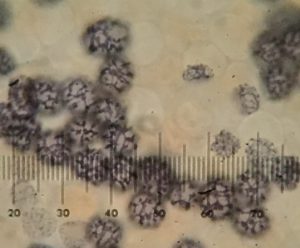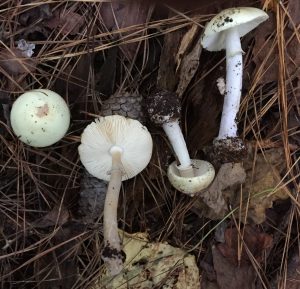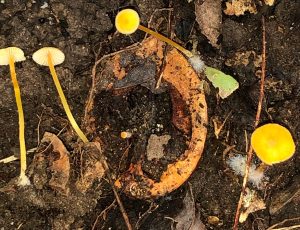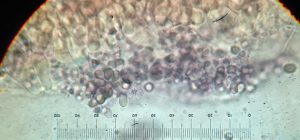by Van Cotter, UNC Herbarium Associate

Mushroom identification relies on many tricks of the trade. One of the fun tricks is treating white mushroom spores with iodine in the form of Melzers Reagent to see if they turn bluish-black (much as iodine will turn the inside of potatoes bluish-black). The term for this reaction is amyloidity. Sometimes only the ornamentation of the mushroom spores will show this amyloid reaction; this is true for the milk mushrooms (Lactarius) (Figure 1.)

In identifying mushrooms, having a black and white trait like amyloidity is a relief compared to traits that are grey and difficult to interpret. For example, the Amanita mushrooms fall into two camps: some have amyloid spores and some do not. Fruiting locally in abundance this past October was Amanita lavendula, a Coker species, which is a member of the camp with amyloid spores (Figures 2 and 3). This species is an ectomycorrhizal partner with pines. Its lavender shades only develop when night temperatures are near freezing. Curiously, the flesh of this mushroom smells like raw potato, a second biochemical ‘connection’ to potatoes. Dr. William C.

Coker, famous UNC Botanist for whom Coker Hall is named, described this Amanita over 100 years ago in 1917.
A current Herbarium project is inventorying the fungi of the North Carolina Botanical Garden which leads us to a neat mushroom that fruited in abundance this fall along the Meeting of the Waters Creek in the North Carolina Botanical Garden Meet Mycena crocea (Figure 4), a cute little agaric that shows what good plant taxonomists fungi are. If one finds this little guy, one can be certain to be in the presence of mature nut bearing trees (walnut, hickory). In addition to its ecology, the amyloidity of its spores is a key feature in identification of M. crocea (Figure 5).

